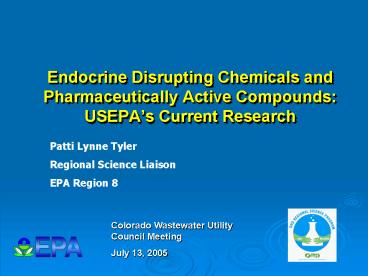Endocrine Disrupting Chemicals and Pharmaceutically Active Compounds: USEPAs Current Research - PowerPoint PPT Presentation
1 / 17
Title:
Endocrine Disrupting Chemicals and Pharmaceutically Active Compounds: USEPAs Current Research
Description:
Are other sewage treatment processes significant sources (septic systems, constructed wetlands) ... exposures to chemicals that interfere with endocrine systems ... – PowerPoint PPT presentation
Number of Views:105
Avg rating:3.0/5.0
Title: Endocrine Disrupting Chemicals and Pharmaceutically Active Compounds: USEPAs Current Research
1
Endocrine Disrupting Chemicals and
Pharmaceutically Active CompoundsUSEPAs
Current Research
Patti Lynne Tyler Regional Science Liaison EPA
Region 8
Colorado Wastewater Utility Council Meeting July
13, 2005
2
Presentation Outline
- EDCs and PPCPs
- What is USEPAs research program for EDCs?
- Understanding basic science
- Understanding impacts on the environment and
human health - Future Research
- Regional Research
- Summary
- Additional Resources Information
3
EDCs vs PPCPs
- EDCs Endocrine Disrupting Chemicals
- PPCPs Pharmaceuticals and Personal Care
Products - EDCs and PPCPs are NOT the same thing
- Only a few PPCPs are known or suspected of being
direct-acting EDCs (e.g., synthetic steroids) - EDCs come from many chemical classes
4
Overview Pharmaceuticalsin the Environment
- Certain pharmaceutically active compounds (e.g.,
caffeine, aspirin, nicotine) have been known for
over 20 years to occur in the environment. - Environmental occurrence primarily resulting
from treated and untreated sewage effluent. - Only more recently has a larger picture emerged
numerous PPCPs can occur (albeit at very low
concentrations). - Prior discovery delayed primarily by limitations
in analytical environmental chemistry
(ultra-trace enrichment and detection). - Domestic sewage is a major source not just
hospital sewage. CAFOs are a major source of
antibiotics.
5
Overview Pharmaceuticalsin the Environment
- Continual input of PPCPs to aquatic environment
via sewage can impart a persistent quality to
those compounds that otherwise possess no
inherent environmental stability. - The full extent, magnitude, and ramifications of
their presence in the aquatic environment are
largely unknown. - Vast majority of all ecological monitoring
studies to date have been performed in Europe
(with exception of USGS). - Use/release of antibiotics and natural/synthetic
steroids to the environment has generated most of
the controversy to date, but a plethora of other
PPCPs have yet to be examined. Scope of overall
issue is ill-defined.
6
Overview Pharmaceuticalsin the Environment
- Toxicological significance for both humans and
ecological exposure to multiple chemicals at
trace concentrations (ppb-ppt) for long durations
is poorly understood. - If PPCPs eventually prove to be an environmental
concern, it is unknown whether sewage treatment
facilities could be cost-effectively modified to
reduce emissions. - Source control (aimed at both disposal and
medical practices) may prove more effective
(environmental stewardship programs). - Focus should be on proper and sufficient science
for establishing occurrence, exposure,
susceptibility/effects, so that sound decisions
can be made regarding human and ecological health
7
USEPAs ED Research Plan
- Long-term Research Goals
- 1. Understand the basic science
- 2. Determine the extent of the problem
8
Long-Term Goals 1 and 2
- Identify major sources of EDCs entering the
environment, with focus on - contaminated sediments
- sources of combustion
- concentrated animal feeding operations (CAFOs)
- drinking water treatment plants
- wastewater treatment plants
- Develop tools for risk management of EDCs, such
as biodegradation processes and identify
pollution prevention strategies
9
Waste Water Treatment Research Questions
- What is the fate of estrogenic EDCs during
wastewater treatment? - Estrogens (ethinyl estradiol) and metabolites
- Alkylphenols and AP ethoxylates
- What is the performance of unit processes in
WWTPs? - What engineering solutions are needed to address
estrogenic EDCs in wastewater and biosolids? - How do current biosolids treatment and disposal
methods perform in treating EDCs? - What is the capacity of aquatic sediments to
manage the input of Alkylphenols and AP
ethoxylates? - Are other sewage treatment processes significant
sources (septic systems, constructed wetlands)?
10
Future Research, Outcomes and Impacts
- Determining the magnitude of adverse impacts of
EDCs on human health - Estimating population level impacts from
exposures to EDCs in representative wildlife
species
11
Future Research, Outcomes and Impacts
- Developing approaches for reducing exposures to
EDCs in contaminated sediment, wastewater
treatment effluents, concentrated animal feeding
operations, and combustion sources
(contd)
12
Future Research, Outcomes and Impacts
- Developing improved methods and models for EDC
exposure assessments - Developing improved approaches for integrated
risk assessments - Incorporating mechanisms of action
- Integrating human health and ecological data
- Taking into consideration risks to susceptible
populations, especially children - Determining aggregate exposure and cumulative risk
(concluded)
13
Regional Research
- Evidence of reproductive disruption in fish
downstream of CO WWTP - Sex ratio skewed towards females
- Intersex increased prevalence
- Unusual ovarian development
- Elevated vitellogenin in downstream juvenile
males
14
Summary
- There is global concern regarding exposures to
chemicals that interfere with endocrine systems - USEPAs long-term research program on EDCs
focuses on determining whether humans and
wildlife populations are being impacted by
current levels of EDCs in the environment,
identifying the sources of those exposures, and
developing approaches to reduce or prevent
exposure to EDCs
15
Additional Resources
- WERF Fact Sheet Endocrine Disrupting
- Compounds and Implications for
- Wastewater Treatment (www.werf.org)
- ORDs Endocrine Disruptors Research Plan
- (www.epa.gov/ord/htm/documents/ORD-EDR-Feb1998.pd
f) - EPAs PPCP Website
- www.epa.gov/nerlesd1/chemistry/pharma
- EPAs Meeting on Pharmaceuticals in the
Environment, Las Vegas, Aug 23-25th - can participate via Website, contact Patti
if interested
16
Additional Resources (cont)
- 1999-2000 USGS implemented first-ever national
reconnaissance of emerging pollutants in waters - Published in 15 March 2002 issue of Environmental
Science and Technology - More information at http//toxics.usgs.gov/highli
ghtswhatsin.htm
17
Contact Information
- Patti Lynne Tyler
- USEPA Region 8
- Regional Science Liaison
- 303.312.6081
- tyler.patti_at_epa.gov































